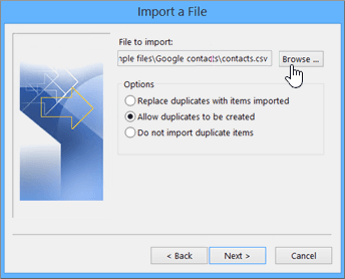

- #UNABLE TO IMPORT .CSV FILE TO ISCRIBE CONTACTS HOW TO#
- #UNABLE TO IMPORT .CSV FILE TO ISCRIBE CONTACTS DOWNLOAD#
- #UNABLE TO IMPORT .CSV FILE TO ISCRIBE CONTACTS FREE#
If you want to get fancy, you can use CSS to define the colors, font, and borders of the data when exported.įor experienced apex developers you may be thinking, “Hold it Doug, I know apex is fancy and all, but you can’t write directly to the output stream for the browser to download a file, so what dark arts are you proposing?” I love Salesforce for this feature! Visualforce pages whose content creates an HTML table can be exported to Excel simply by setting the contentType attribute of the tag to “application/vnd.ms-excel#filename.xls”. Check out simple examples here and here. if querying Contacts then you can’t query account.name field from related account - you would need to create formula fields on your object that pull that related data in and query the formula field directly instead, like account_name_c).įor the inner programmer in you, it is possible to use Apex and/or Visualforce to generate. csv option uses the Bulk API, so relationship fields can’t be used (e.g. You can, as with the other data loaders, pick the object and fields you want and the query is generated for you, or you can manually write your own SOQL query.

Although there are lots of things you can do with this tool, for our purposes in data export just navigate to Queries | SOQL Query after logging in. Workbench allows users to describe, query, manipulate, and migrate both data and metadata in Salesforce directly in their web browser with a simple and intuitive user interface. Workbench, developed by Ryan Brainard, is a powerful, web-based suite of tools designed for administrators and developers to interact with Salesforce via the APIs.
#UNABLE TO IMPORT .CSV FILE TO ISCRIBE CONTACTS FREE#
The free plan is more than enough for the average use case, but if you need to move more than 50,000 records a month then reasonable paid options exist too. A neat benefit is you can save data to your computer, Dropbox, Box, SFTP, or a database. This is another tried-and-true option for importing and exporting data in. It has a user interface for selecting the object and fields and criteria, or you can write your own SOQL query. It also supports command line scripting if you wanted to automate a recurring export.įor a cloud-based alternative to the Salesforce Data Loader, check out by MuleSoft. The tool gives you a nice user interface to pick the object and fields and criteria for the data you want to export, or write your own SOQL query. To download the tool, in Salesforce navigate to Setup | Data Management | Data Loader. It is officially developed and supported by Salesforce. Tried-and-true, the Salesforce Data Loader has been the go-to tool for administrators needing to import or export data to/from Salesforce in. Don’t delay, the files expire after 48 hours. The administrator who schedules the export will receive an email with the link to download the files when they’re ready. Mainly marketed as a data backup service built right into Salesforce, you can schedule to have some or all of your objects exported to individual. csv is to use the Data Export scheduling tool. The next simplest way to mass export data to. The simplest option is to create a report then export the details as.
#UNABLE TO IMPORT .CSV FILE TO ISCRIBE CONTACTS HOW TO#
These won’t break the budget and generally do one thing very well and are easy to learn how to use. Sometimes you need a hammer, sometimes you need a jack-hammer. Think of this as you’ve walked into a hardware store and you’re seeing all the various tools at your disposal. Each have their merits and balance between cost, complexity, and versatility. I have grouped the options into four categories. Whatever the reason, I’ll show you some easy ways to export your data to. Maybe you just love to play with spreadsheets (no judgements here!) Maybe you need it for integration to another system? I mean, how else can you run automation workflow and lovely reports if there’s no data? And that’s great, you got the data into Salesforce, but what about getting the data out?

The beloved phrase all Salesforce admins eventually learn and evangelize when training users to log their data and activities into Salesforce so that manager reports can show meaningful metrics. “If it’s not in Salesforce, then it doesn’t exist.”


 0 kommentar(er)
0 kommentar(er)
